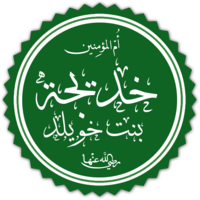Khadijah bint Khuwaylid
| Khadija Mother of the Believers |
|
|---|---|
 |
|
| Native name | (Arabic): خديجة |
| Born |
Khadīja bint Khuwaylid c. 555 C.E or 567 (according to earlier sources) Mecca, Hejaz, Arabia
(present-day Saudi Arabia) |
| Died | 620 C.E (aged c. 53–65) Mecca, Hejaz, Arabia
(present-day Saudi Arabia) |
| Resting place |
Jannat al-Mu'alla, Mecca, Hejaz, Arabia (present-day Saudi Arabia) |
| Other names | Khadīja al-Kubra |
| Spouse(s) | 'Atiq ibn 'A'idh Al-Makhzumi Abu Hala Malak ibn Nabash Muhammad |
| Children | Hind bint Atiq Abdullah ibn Atiq Hala ibn Abi Hala Hind ibn Abi Hala Zaynab bint Abi Hala Qasim ibn Muhammad Abd-Allah ibn Muhammad Zaynab bint Muhammad Ruqayyah bint Muhammad Umm Kulthum bint Muhammad Fatimah bint Muhammad |
| Parent(s) |
Khuwaylid ibn Asad Fatimah bint Za'idah |
| Relatives |
Asad ibn Abd-al-Uzza (grandfather) Halah bint Khuwaylid (sister) Waraqah ibn Nawfal (cousin) |
Khadijah or Khadīja bint Khuwaylid (Arabic: خديجة بنت خويلد) or Khadīja al-Kubra (Khadija the Great) (c. 555 or 567 – 620 CE) was the first wife and follower of the Islamic prophet Muhammad. She is commonly regarded by Muslims as the "Mother of the Believers" (i.e., Muslims).
Khadija's grandfather, Asad ibn Abd-al-Uzza, was the progenitor of the Asad clan of the Quraysh tribe in Mecca. Her father, Khuwaylid ibn Asad, was a merchant. According to some traditions, he died c. 585 in the Sacrilegious War, but according to others, he was still alive when Khadija married Muhammad in 595. His sister, Umm Habib bint Asad, was the matrilineal great-grandmother of Muhammad. Khadija's mother, Fatima bint Za'idah, who died around 575, was a member of the Amir ibn Luayy clan of the Quraysh and a third cousin of Muhammad's mother.
Khadija married three times and had children from all her marriages. While the order of her marriages is debated, it is generally believed that she first married Abu Hala Malak ibn Nabash ibn Zarrara ibn at-Tamimi and second 'Atiq ibn 'A'idh ibn 'Abdullah Al-Makhzumi. To her first husband she bore two sons, who were both given what were usually feminine names, Hala and Hind. He died before his business became a success. To husband Atiq, Khadija bore a daughter named Hindah. This marriage also left Khadija as a widow.
Khadija became a very successful merchant. It is said that when the Quraysh's trade caravans gathered to embark upon their summer journey to Syria or winter journey to Yemen, Khadija's caravan equalled the caravans of all other traders of the Quraysh put together. She was known by the by-names Ameerat-Quraysh ("Princess of Quraysh"), al-Tahira ("The Pure One") and Khadija Al-Kubra (Khadija "the Great"). It is said that she fed and clothed the poor, assisted her relatives financially and provided marriage portions for poor relations. Khadija was said to have neither believed in nor worshipped idols, which was atypical for pre-Islamic Arabian culture. According to other sources, however, she kept an idol of Al-‘Uzzá in her house.
...
Wikipedia
